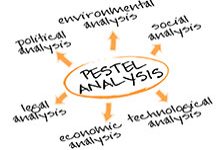Strategic Planning: For Leaders
What is Strategic Planning?
Strategic planning is both an “event” and an “ongoing process” that aims to define the organisations strategy, or the direction that the organisational will pursue. Typically strategic planning has four steps- Analysis of your business operating environments (Internal, Industry and Macro environments) often summarised in a SWOT analysis
- Strategic choice or making a decision based on your analysis
- Implementation of the strategic plan
- Review the outcomes and refine the plan
In many organisations the senior managers attend a one to three day strategic planning event either annually or every second year. During this event they brainstorm their analysis and progress the analysis through to the development of a strategy.
However, once a strategy is developed and documented then the “ongoing strategic process” will commence with the managers continuing to observe their strategic environment for changes, when a change in the environment is observed the impact of this change on the businesses current strategic plan will be considered.
Also see definition of strategic planning in Wikipidia
Strategic Planning Guide

The first step to successfully developing a strategy for your business is to complete an analysis of your businesses three strategic environments. This analysis can be summarized using the SWOT Analysis technique.
The three strategic environments that you will analyse are your
The three strategic environments that you will analyse are your
SWOT Analysis
The SWOT technique is an easy to learn tool that you can use to summarize your businesses Strengths Weaknesses, Opportunities and Threats. The SWOT technique is widely used in business as it provides structure and, when complete, presents your analysis in a logical easy to follow format.
SWOT Analysis How to Guide
View SWOT Templates
Download Templates
SWOT Examples
Macro Environment Analysis or PESTEL Analysis
The macro environment or PESTEL analysis is used to analyse the global/regional/national trends that may impact on or provide opportunity for your business. These trends include political, economic, social, technological, environmental and legal trends. Use our templates and sample analysis questions to guide you though your analysis.
Pestle "How To" guide
Pestle "How To" guide
Industry Environment Analysis or Porters Five Forces
Porter’s five forces is a method that you can use to analyze how turbulent your industry is/will be. Sometimes people confuse the presence of a single low priced competitor as high levels of competition, however having competitors at various price points does not by itself create a turbulent industry. Use our analysis tools to help you to analyze your industry.
Porters Five Forces "How To" Guide
Porters Five Forces "How To" Guide
- Competitive Rivalry
- Bargaining Power of Customers
- Bargaining Power of Suppliers
- Threat of New Entrants
- Threat of Substitutes
Internal Analysis
An internal analysis is completed to determine what your business is good at and what you are not so good at. A strength is generally something that your customers value and that you are better than your competitors at. For example you may have a great culture and amazing leadership (both strengths, but unlikely to be valued by your customer) however it leads to your employees putting in the extra effort to service your customers, this service maybe a strength.
Internal Analysis "How To" Guide
Internal Analysis "How To" Guide
Strategic Planning Guide "Value Adds"
- Strategic Leadership
- Embedding Strategy through Management by Walking Around
- Basic Strategic Planning Model
Free Downloads

- Strategic Planning Template
- Macro Environment Analysis Template
- Porters Five Forces Template
- SWOT analysis template
- Simple SWOT Template
- Distinctive SWOT Template
- Ultimate SWOT Template






